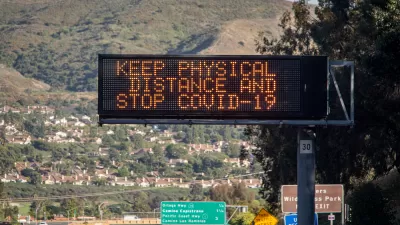Though more and more cities realize that walkability and livable streets are essential to their prosperity, their approach to pedestrian safety is often lacking. The slow pace of policy change isn't fast enough for the victims of "accidents".
Cities like New York, San Francisco and, increasingly, Los Angeles are known for their lively street life. But as recent news stories indicate, they're becoming equally well known for their abysmal record of protecting pedestrians from vehicular collisions, and punishing drivers who kill and injure those on two feet.
Sarah Goodyear has written with eloquent outrage about the lack of consequences for drivers who plough into pedestrians on New York's streets and sidewalks, and elsewhere. The latest incident to catch her ire involves the striking of five children by an out-of-control driver on a sidewalk in the Maspeth neighborhood of Queens last week.
"You might think, if you’re not from New York, that the guy who was behind the wheel would automatically be in big trouble for causing this kind of mayhem," she says. "But as I've written before, it isn’t like that here."
The New York Police Department has gone to great lengths to publicize reforms to how it handles traffic crashes. As Kate Hinds points out in her article on the Maspeth incident for Transportation Nation, "[e]arlier this year the NYPD instituted reforms to its then-named Accident Investigation Squad, whose 19 officers covered the entire city and only investigated traffic crashes resulting in death. Now, the newly renamed Collision Investigation Squad is taking a harder look at more crashes." However, as another recent article by Goodyear indicates, the "considerable expansion of police resources toward traffic safety" doesn't seem to have radiated throughout the department.
Planetizen has just published an article that looks at one promising tool that's being deployed in New York City: Pedestrian/Traffic Managers (PTM's). Though they've been shown to increase pedestrian safety in select areas of the city, the PTM is a tool that has limited application. You can't deploy a PTM at every street corner. And even if you could, that wouldn't prevent the inevitable "out-of-control" driver.
In Los Angeles, where almost half of all crashes are hit-and-runs, a new state law will increase the statute of limitations for such incidents from three years to six. "It is a small step forward, not just legally, but also in terms of signaling that the community at large recognizes that the hit-and-run epidemic is real," observes Goodyear. However, "[i]nvestigations by the LAPD into hit-and-run crimes are all too often lackluster, as [Simone] Wilson’s reporting in LA Weekly showed. And if the police aren’t motivated to search out those who drive away from the scene of a crash, it doesn’t matter if the statute of limitations is 3 years, or 6, or 26.
Though the official approach to pedestrian safety and traffic collisions appears to be improving, tell that to the Queens eight grader with the broken pelvis or the British tourist whose leg was severed in Midtown Manhattan.
FULL STORY: Even After 5 Kids Were Mowed Down on a New York Sidewalk, Nothing Much Changes

Planetizen Federal Action Tracker
A weekly monitor of how Trump’s orders and actions are impacting planners and planning in America.

Maui's Vacation Rental Debate Turns Ugly
Verbal attacks, misinformation campaigns and fistfights plague a high-stakes debate to convert thousands of vacation rentals into long-term housing.

San Francisco Suspends Traffic Calming Amidst Record Deaths
Citing “a challenging fiscal landscape,” the city will cease the program on the heels of 42 traffic deaths, including 24 pedestrians.

Amtrak Rolls Out New Orleans to Alabama “Mardi Gras” Train
The new service will operate morning and evening departures between Mobile and New Orleans.

The Subversive Car-Free Guide to Trump's Great American Road Trip
Car-free ways to access Chicagoland’s best tourist attractions.

San Antonio and Austin are Fusing Into one Massive Megaregion
The region spanning the two central Texas cities is growing fast, posing challenges for local infrastructure and water supplies.
Urban Design for Planners 1: Software Tools
This six-course series explores essential urban design concepts using open source software and equips planners with the tools they need to participate fully in the urban design process.
Planning for Universal Design
Learn the tools for implementing Universal Design in planning regulations.
Heyer Gruel & Associates PA
JM Goldson LLC
Custer County Colorado
City of Camden Redevelopment Agency
City of Astoria
Transportation Research & Education Center (TREC) at Portland State University
Jefferson Parish Government
Camden Redevelopment Agency
City of Claremont




























